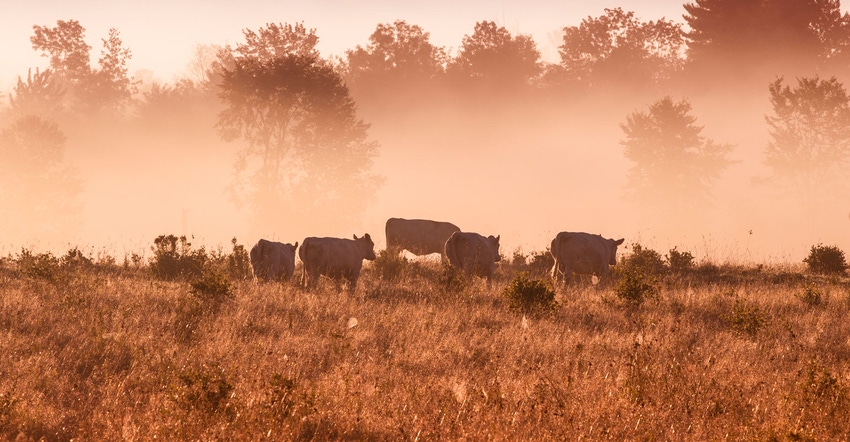June 29, 2021

Current drought conditions across Minnesota will have seasonlong impact on pastures.
University of Minnesota Extension educator Eric Mousel and Extension veterinarian Joe Armstrong offer these five tips to help prepare for summer grass grazing shortages.
1. Monitor your cattle drinking water source. Surface water is often the main source of water for grazing cattle, and it can dry up. This can be remedied if a live water tap is near fill tanks. If a live water tap is not available, moving cattle out of the pasture or hauling water may be your only alternatives for the short term.
Keep in mind that a cow will drink 20 gallons and calves will drink 5 to 8 gallons per day before you make that decision. That is a lot of water to haul, and you can’t let them run out. A cow can go a couple of days with no water, which is not the issue. The issue is trampled calves at the tanks when you start dumping fresh water. If you are going to haul water, start hauling well in advance of natural surface water running out, so cows have a chance to establish their new pecking order before it becomes a dire situation.
Keep in mind that cows will continue to return to the old pond even after it is dried up. This is generally disastrous for calves, who become bogged in the silt at the bottom of the pond bed. We’ve seen it happen several times already this summer. Once you have established a new water supply, fence out the old water with a strand of hot wire to keep cattle out of the silt bed.
2. Creep-feed calves. Creep-feeding calves could be a possible grass-saver for some operations. Feed is expensive right now, but it may be the only option remaining before carving up the herd. Keeping calves on a low to moderate energy creep will reduce grass intake by as much as 20%. If you are considering putting some creep feed out for calves, check out this University of Nebraska guide for information on possible feed formulations, bit.ly/unlcreepfeed.
3. Cull cows now. We are past the point in the growing season where additional rain is going to restore things to normal for this year. Rain will certainly help, but grass yields will still suffer tremendously.
So, a couple of thoughts about pruning the cow herd:
• Don’t wait till you’re out of grass. Most cow herds can be kept intact if 10% to 25% of the herd is liquidated now. If you have something else to feed them until fall, that is fine, but most folks do not — and it probably isn’t very profitable to do so.
• If you bred early, preg-check and sell opens and late-breds. There is no reason to keep feeding the opens and late-calving cows are the least profitable in your herd.
• Sell the oldest cows first, even if they are still decent cows. They are the least valuable to your remaining cow herd. If you don’t have many older cows, cut into the older end of the running age cows next (6- to 8-year-olds). If you still need to trim some mouths, consider cutting into the replacement heifers. This will leave you a core group of your most valuable cows, ages 3 to 6 years old.
• Selling pairs or bred pairs isn’t going to be much of a possibility this summer. Things may change, but this drought extends over 75% of cow country right now, so there aren’t many farmers looking for more mouths to feed. Early weaning of calves might be the way to go.
4. Wean calves early. Early weaning of calves is an option to lighten the load on remaining grass. This practice has been shown to reduce grass intake of cows by about 25%. Calves can be successfully weaned at about 90 days of age and started on feed relatively easily, particularly if they have been creep-fed prior to weaning. Nutrition is the key component to a successful early weaning program. Consult a nutritionist to formulate a least-cost ration specific to feed ingredients you have on hand.
Other major considerations for early weaning include performing standard vaccinations prior to weaning, controlling dust to mitigate dust pneumonia potential, and adequate fly control. Manage heat stress in calves as much as possible by providing shade and plenty of clean water.
5. Control flies and other pests. Pest control is more critical during a drought. Cows and calves are hounded relentlessly by biting flies, face flies, mosquitoes and ticks in a pasture setting, and dry weather tends to make it worse. Cattle use a lot of energy fighting flies and they tend to bunch, which makes heat stress worse. Provide relief from flies to cattle on grass or in drylots with dust bags, oilers, rubs and/or fly tags. Make sure you keep them fresh and current.
For more information about fly control in a pasture setting, check out this University of Nebraska-Lincoln guide online at bit.ly/unlfliescattle.
Source: University of Minnesota Extension, which is solely responsible for the information provided and is wholly owned by the source. Informa Business Media and all of its subsidiaries are not responsible for any of the content contained in this information asset.
You May Also Like




